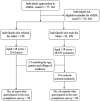Perceptions Associated with Noncompliance to Community-Wide Mass Drug Administration for Soil-Transmitted Helminths
- PMID: 37604467
- PMCID: PMC10551087
- DOI: 10.4269/ajtmh.23-0176
Perceptions Associated with Noncompliance to Community-Wide Mass Drug Administration for Soil-Transmitted Helminths
Abstract
Mass drug administration (MDA) is a key strategy for the control of soil-transmitted helminths (STHs). Within MDA programs, poor and non-random compliance threaten successful control of STHs. A case-control study was conducted comparing perceptions among non-compliant participants with compliant participants during a community-wide MDA (cMDA) with albendazole in southern India. Common reasons cited for non-compliance were that the individual was not infected with STH (97.4%), the perception that he/she was healthy (91%), fear of side-effects (12.8%), and dislike of consuming tablets (10.3%). Noncompliance was associated with poor awareness of intestinal worms (odds ratio [OR]: 9.63, 95% CI: 2.11-43.84), the perception that cMDA was only required for those with worms (OR: 2.14, 95% CI: 1.06-4.36), and the perception that the drug is not safe during pregnancy (OR: 2.19, 95% CI: 1.18-4.07) or when on concomitant medications (OR: 3.14, 95% CI: 1.38-7.15). Understanding of perceptions driving noncompliance can provide valuable insights to optimize participation during MDA for STHs.
Figures
Similar articles
-
Coverage of community-wide mass drug administration platforms for soil-transmitted helminths in Benin, India, and Malawi: findings from the DeWorm3 project.Infect Dis Poverty. 2024 Oct 8;13(1):72. doi: 10.1186/s40249-024-01241-0. Infect Dis Poverty. 2024. PMID: 39380086 Free PMC article. Clinical Trial.
-
Community Drug Distributor Knowledge, Attitudes, and Motivation Surrounding Mass Drug Administration for Soil-Transmitted Helminths in India.Front Public Health. 2021 Nov 23;9:714606. doi: 10.3389/fpubh.2021.714606. eCollection 2021. Front Public Health. 2021. PMID: 34888277 Free PMC article.
-
Evaluation of opportunities to implement community-wide mass drug administration for interrupting transmission of soil-transmitted helminths infections in India.PLoS Negl Trop Dis. 2023 Mar 10;17(3):e0011176. doi: 10.1371/journal.pntd.0011176. eCollection 2023 Mar. PLoS Negl Trop Dis. 2023. PMID: 36897877 Free PMC article. Clinical Trial.
-
Preventive Chemotherapy in the Fight against Soil-Transmitted Helminthiasis: Achievements and Limitations.Trends Parasitol. 2018 Jul;34(7):590-602. doi: 10.1016/j.pt.2018.04.008. Epub 2018 May 29. Trends Parasitol. 2018. PMID: 29858018 Review.
-
Anthelmintic resistance in soil-transmitted helminths: One-Health considerations.Parasitol Res. 2023 Dec 20;123(1):62. doi: 10.1007/s00436-023-08088-8. Parasitol Res. 2023. PMID: 38114766 Free PMC article. Review.
References
-
- National Vector Borne Disease Control Programme, Directorate General of Health Services, Ministry of Health and Family Welfare, Government of India , 2018. Accelerated Plan for the Elimination of Lymphatic Filariasis. Available at: https://nvbdcp.gov.in/WriteReadData/l892s/1031567531528881007.pdf. Accessed May 6, 2023.
-
- Babu BV, Babu GR, 2014. Coverage of, and compliance with, mass drug administration under the programme to eliminate lymphatic filariasis in India: a systematic review. Trans R Soc Trop Med Hyg 108: 538–549. - PubMed
-
- Kumar A, Kumar P, Nagaraj K, Nayak D, Ashok L, Ashok K, 2009. A study on coverage and compliance of mass drug administration programme for elimination of filariasis in Udupi district, Karnataka, India. J Vector Borne Dis 46: 237–240. - PubMed
Publication types
MeSH terms
Substances
LinkOut - more resources
Full Text Sources


